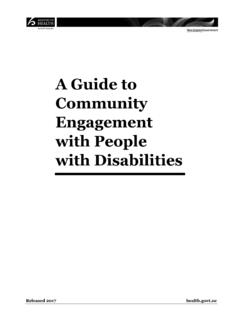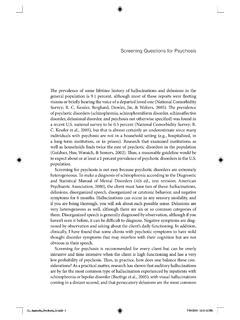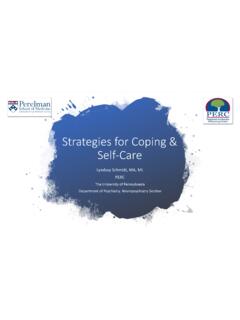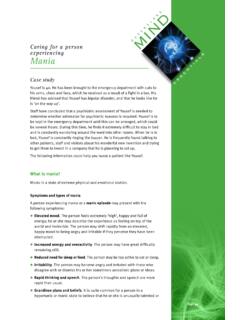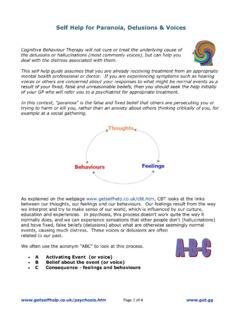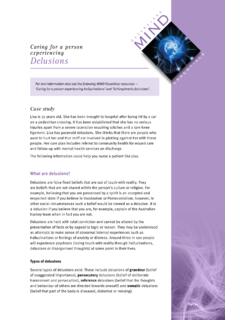Transcription of Psychosis Screening in Primary Care
1 Informational tool produced by the Center for Early Detection, Assessment, and Response to Risk (CEDAR) in conjunction with the Prevention Collaborative, the Massachusetts Child Psychiatry Access Project (MCPAP), Boston Children s Hospital (BCH) Adolescent Medicine and BCH Psychiatry. This work was funded by the Sydney R. Baer, Jr. Foundation, the Massachusetts Department of Mental Health, MCPAP, and the Beth Israel Deaconess Medical Center and Harvard Medical School Departments of Screening in Primary CareMassachusetts VersionJuly Pages 4A Place for Caution and Balance 8 KNOW THE SIGNS 9 What is Psychosis ? 9 Family History & Other Risk Factors 10 Signs of Psychosis 12 FIND THE WORDS 15 Tips for Talking About Psychosis 15 Screening & Follow-Up Questions 15 Case Examples 18 Could This Be Depression?
2 Anxiety? ADHD? 22 MAKE THE CONNECTION 28 Medical Workup Considerations 29 PATH 1: Reassure & Redirect 32 PATH 2: Monitor & Educate 34 Monitoring Symptoms, Behavior, & Risk 35 Educational Resources 36 Treatment & Assessment Resources 37, 39 PATH 3: Specialized Assessment & Treatment 38 PATH 4: Same-Day Assessment 42 APPENDIX 43 Tips for Talking with Parents & Caregivers 4416-Item Prodromal Questionnaire (PQ-16) 46contentsMAKE THECONNECTIONFIND THE WORDS KNOWTHE SIGNS Brain abnormalities emerge ACTIONS may help prevent THECONNECTIONFIND THE WORDS KNOWTHE SIGNS that are common early indicators of psychosisto ask about warning signs and psychotic experiencesto appropriate assessment & treatment resourcesYou would act immediately if a patient showed the early signs of a stroke.
3 responding quickly to the early signs of mental illness is just as critical for patients health and wellbeing. Recovery can be a realistic goal with timely help. The next few pages provide a QUICK REFERENCE GUIDE. More detailed information on each topic begins on page INTERVENTIONP rimary careEarly Warning SignsPsychosisOnsetRelapsing Psychosis & Chronic IllnessPatient s Health StatusSTANDARD INTERVENTIONE mergency RoomAGE:0102030405060 Ages 12-35: peak risk for psychotic disordersEARLYINTERVENTIONCAN SAVE LIVESThis booklet was designed to help providers working with adolescents and young adults:EARLY INTERVENTION CAN:Quality of life FunctioningSuicide risk Care utilization Medical costsINCREASEDECREASEFACTS will help you remember the most common early warning signs.
4 Patients for whom any of these are new or worsening should be assessed further (see FIND THE WORDS): KNOWTHE SIGNS FACTSFUNCTIONING: Functional decline Decline in performance at school/work Withdrawal from family, friends, and usual activities Changes in sleep patterns ATYPICAL: Atypical perceptual experiences Seeing things not there: , shadows, flashes, figures, people, or animals Hearing things others do not: , clicking, banging, wind, mumbling, or voices Seeing or hearing everyday experiences as unfamiliar, distorted, or exaggeratedCOGNITION: Cognitive difficulties Memory, attention, organization, processing speed Understanding abstract concepts, social cues, complex ideasTHOUGHTS: Thought disturbance or unusual beliefs Unwarranted suspiciousness about friends, family or strangers Unfounded concern something is wrong with their bodies Thinking that their body or mind has been altered by an external force Believing others can read their mind or control their thoughtsSPEECH.
5 Speech or behavior that is disorganized Trouble putting thoughts into words Speaking in jumbled or hard to follow sentences Dressing inappropriately for the weather or behaving oddlyFamilial RiskFamily history is the best known predictor of Psychosis . Regular monitoring for changes in mental health and functioning in these patients is advised, as subtle warning signs are more concerning. That said, most patients with a family history of a major psychotic disorder will NOT develop a psychotic the WordsFIND THE WORDS 45 When patients present with nonspecific signs of risk, such as general difficulties in FUNCTIONING, COGNITION, or SPEECH, the following Yes/No questions can help tease out if these are related to psychotic experiences: Have you started to wonder if your mind was trying to trick you or was not working right?
6 Have you felt confused whether an experience was real or imaginary? Have you thought that some person, force, or creature was around you, even though you couldn t see anyone? Have your thoughts been so strong that you felt like you heard them or worried other people could hear them? Have you seen objects, people, or animals that no one else could see? Have you heard voices or sounds that no one else could hear? Have you thought that the world may not be real or that you may not be real? Have you thought that people were following or spying on you?For spontaneous disclosures or positive responses to these or similar questions (ATYPICAL perceptual experiences, THOUGHT disturbance or unusual beliefs), follow up with some of these open-ended questions:What is the EXPERIENCE like?
7 Tell me more about that experience. What do you make of that? Why do you think this is happening? How so?Is it IMPACTING them? What do you do/how do you feel when that happens? Do you ever do anything differently (as a result of that thought/experience)? Does it ever bother you? Do you ever worry that (that s true, it s going to get worse, or that you re going to lose track of whether something is real or not)?Is it RECURRING or PROGRESSING? How often is this happening? Does it seem to be happening more now than it used to? When did you first begin having this experience? Has this experience changed at all over time? (for instance, becoming more intense or harder to dismiss) 6 Use what you ve observed and learned in FIND THE WORDS to consider one of the following paths.
8 For rapid assistance choosing the appropriate path, call MCPAP ( ) or consult the resources on page THECONNECTIONIF:Symptoms are not psychotic-like or are better explained by: Cultural/familial norms Developmental stage Other mental/medical health diagnosesIF: Mild or vague psychotic- like content is not IMPACTING, RECURRING, or PROGRESSING Family history of psychosisIF: Psychotic-like content is IMPACTING, RECURRING, or PROGRESSING Suspicious/concerned Psychosis may be emerging even without relevant self-disclosureIF: Suicidal/violent thoughts or impulses Significantly out of touch with reality Behavior is severely disorganized or dangerous Questionable ability to manage command hallucinations to hurt themselves or someone else PATH 1: REASSURE & REDIRECTPATH 2: MONITOR & EDUCATEPATH 3: SPECIALIZED ASSESSMENT & TREATMENTPATH 4: SAME-DAY ASSESSMENTTHEN: Reassure the patient.
9 Help them put their experience in context and know they are not alone Connect them to relevant educational resources and/or redirect them to appropriate mental health treatmentTHEN: Monitor the patient s symptoms and screen regularly for additional psychotic-like experiences Educate the patient and family on general mental health resources and direct them to call if symptoms increase in intensity, frequency, or impactTHEN: Refer the patient to specialized assessment of Psychosis and/or Psychosis risk Seek consultation/specialized treatment optionsTHEN:If these are not sufficiently managed by existing treatment: Seek consultation from MCPAP or mental health professional trained to address this level of need Respond to risk of harm using established protocols Consider calling a mobile crisis team or recommending that the family bring the child to a Psychiatric Emergency RoomPage 32 Page 34 Page 38 Page 4267 Path 1*Path 2 Path 4 Path 3 NONOYESYESNONOYESDoes the patient: Have a positive behavioral health screen?
10 Show new or worsening FUNCTIONAL decline or COGNITIVE difficulties?*Screen for psychosisYESDid the patient disclose, or did you observe:ATYPICAL perceptual experiences THOUGHT disturbance or delusionsSPEECH or behavior that is disorganizedIs there a safety concern?Are any of the following true?The experience is IMPACTING their emotions, behavior, or functioningThe experience is RECURRING The experience is PROGRESSINGIs there a safety concern?NONOYESNOYESWhat is the EXPERIENCE like?Is it odd and not explained by the patient s cultural, medical, or developmental context?** See pages 29-31 for considerations on differential medical work-up prior to or in conjunction with selection of a Path.
